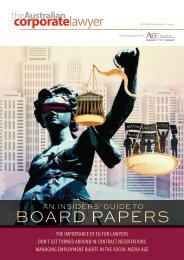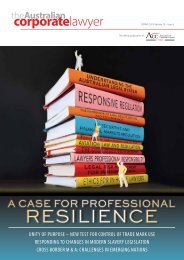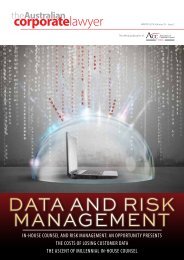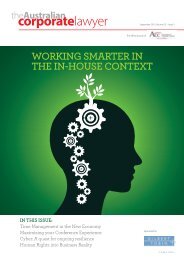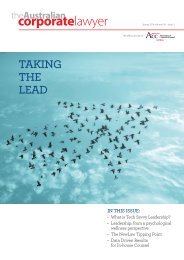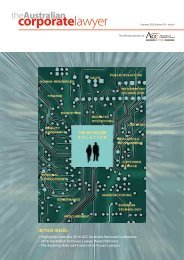Australian Corporate Lawyer - Autumn 2018
Australian Corporate Lawyer is the official publication of the Association of Corporate Counsel (ACC) Australia. The Autumn 2018 issue focuses on 'Ethics and Compliance' and features a range of articles covering topics including: can innovation and compliance co-exist? keeping the house ethically clean; and global subsidiary compliance.
Australian Corporate Lawyer is the official publication of the Association of Corporate Counsel (ACC) Australia. The Autumn 2018 issue focuses on 'Ethics and Compliance' and features a range of articles covering topics including: can innovation and compliance co-exist? keeping the house ethically clean; and global subsidiary compliance.
Create successful ePaper yourself
Turn your PDF publications into a flip-book with our unique Google optimized e-Paper software.
the<strong>Australian</strong>corporatelawyer<br />
ESTABLISHING EFFECTIVE COMPLIANCE<br />
FRAMEWORKS USING DATA ANALYTICS<br />
How Carlton & United Breweries (CUB) are using data analytics to add value and remove risk.<br />
We at Carlton & United Breweries (CUB) proudly brew beer –<br />
Victoria Bitter, Carlton Draught, Wild Yak, and the list goes on.<br />
While we might not be the first brand that comes to mind<br />
when it comes to data analytics and compliance regimes,<br />
we have begun using algorithms and automation in our compliance<br />
routines as we build up our capacity toward more advanced AI techniques.<br />
We view this as the future of compliance and we have embraced the use<br />
of data analytics to proactively identify risk areas before problems occur<br />
and to develop tighter standards of control and accountability within our<br />
operations. Given the increase in regulator activity and the potential for<br />
instantaneous and widespread reputational damage with the prevalence<br />
of social media, we view this as a sound business practice and one that can<br />
reinforce a strong culture of compliance.<br />
What does a beer company have to do with data analytics?<br />
At CUB, our in-house Legal and <strong>Corporate</strong> Affairs team regularly looks<br />
for innovative ways to add value to the business – it is part of our DNA<br />
and our mandate. We took this approach to compliance in connection<br />
with the recent combination of our parent company with AB InBev, the<br />
world’s largest brewer. We had been using data analysis and algorithms in<br />
connection with mergers & acquisitions transactions in the past.<br />
With compliance, we decided that a similar approach could be used to<br />
create long-term value for the business. Large sets of data, looking for<br />
patterns and looking for areas of concern --- conceptually, the approaches<br />
were similar.<br />
We made the decision to invest in the technology and capabilities to build<br />
a platform that would allow us to identify higher-risk areas of compliance<br />
concern. This allowed us to focus our lean internal resources on those areas<br />
that the data analysis showed were more likely to generate issues in the<br />
future.<br />
The process involved developing a data aggregation and analytics program<br />
that could handle vast quantities of data across the recently integrated<br />
multinational businesses with inputs from various different data sources.<br />
We use algorithms and predictive data analytics to spot risky transactions<br />
more quickly and efficiently. This in turn achieves significant cost savings<br />
as compared with having several lawyers and auditors scour through vast<br />
numbers of documents in response to a compulsory notice or investigation.<br />
The Financial Times reviewed this project and awarded it the Standout<br />
Award ‘Innovative lawyers 2017: Data, knowledge and intelligence – inhouse<br />
legal teams.’ Already we have been able to focus our training and<br />
expertise on higher-risk parts of the business.<br />
We anticipate that this accuracy will only improve as we refine the<br />
algorithms based on prior results, removing false positive data and learning<br />
how our data speaks between systems. Eventually, we want machine<br />
learning to be able to assist significantly in refining these algorithms but we<br />
have many steps to go before that phase.<br />
What are ‘data analytics’?<br />
Essentially, data analytics is the process of extracting and categorising<br />
data, and then using qualitative and quantitative techniques to analyse<br />
underlying behavioural patterns, in order to enhance business productivity<br />
and operations. Importantly, our data analytics project features a centralised<br />
and standardised repository that draws upon data from sales, finance and<br />
other business systems to identify transactions and parties that pose a<br />
high risk of antitrust non-compliance, fraud or corruption. The test results<br />
26 | VOLUME 29, ISSUE 1 – AUTUMN <strong>2018</strong><br />
and high-risk transactions are then presented in interactive dashboard<br />
suites. Fortunately for us, you don’t need to know the difference between a<br />
paired T-test and independent T-test to read and interpret the user-friendly<br />
dashboards!<br />
Although most of our models involve machine learning, automation<br />
and algorithms, it is useful for in-house lawyers to understand some of<br />
the underlying techniques. A key technique is regression analysis, which<br />
involves measuring the statistical relationship between certain variables.<br />
This enables us to test the relationships and levels of risks between<br />
particular variables.<br />
Predictive coding is a particularly useful tool for e-discovery document<br />
review processes. It undertakes keyword searches, then filters and samples<br />
relevant documents. This reduces the number of non-responsive and<br />
irrelevant documents that need to be manually reviewed by lawyers, whilst<br />
bringing potentially relevant material to the forefront for legal review. This<br />
is more accurate and cost-effective than having a large team of lawyers<br />
manually review thousands of documents.<br />
What are the benefits of using data analytics?<br />
Proactive compliance and regulatory risk management<br />
In contrast to concerns raised by the <strong>Australian</strong> Competition and Consumer<br />
Commission about companies that use machine learning and artificial<br />
intelligence to fix prices, collude with competitors or mislead consumers,<br />
we strive to use data analytics proactively in compliance, and eliminate<br />
compliance concerns where they may appear. Our data analytics project<br />
allows us to identify high-risk areas and establish controls in those areas to<br />
mitigate risks before they become problematic. For example, our project<br />
facilitates a holistic review of our vendors to protect against certain issues<br />
and unusual transactions. Our program also illuminates fraud, graft and<br />
leakage, allowing us to proactively resolve and prevent these issues.<br />
For example, we proactively manage compliance with antitrust laws by<br />
regularly monitoring and reviewing various conversations with competitors<br />
and stakeholders for any potential concerted practices, cartel conduct or<br />
other antitrust issues. We also create firewalls to mitigate the risk of cross<br />
border non-compliance.<br />
We continually review and improve our compliance framework. This means<br />
that our lawyers are always looking for ways to prevent issues before they<br />
occur, rather than being too occupied putting out fires.<br />
Leader in compliance mentality<br />
We choose to be proactive rather than reactive and to broadcast our strong<br />
compliance culture internally. Having the best-in-class compliance system<br />
improves our business processes and people know that we are more<br />
likely to find irregular patterns or odd behaviours. When you’re likely to be<br />
caught, people tend to think twice before stepping across the line.<br />
That mentality supports our company principle of 'No Shortcuts' and helps<br />
reinforce the strong 'Tone from the Top' that is a strong part of our company<br />
culture. We believe that in the long run this reduces risk and the costs of<br />
investigating external requests.<br />
Meaningful impacts on business operations<br />
As our systems are pulled more closely together, we are able to access<br />
larger, more aggregated and more detailed data about various aspects<br />
of the business. This means that we can track the change of processes<br />
proactively, rather than self-reporting reactively and retrospectively. We<br />
can detect and assess anomalies across the business. This enables us to<br />
flag higher-risk payments for further scrutiny before they are made, such as<br />
duplicate transactions or payments involving a government organisation.



